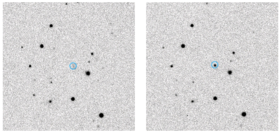
Back IPTF14hls Arabic IPTF14hls Catalan IPTF14hls Czech IPTF14hls Greek IPTF14hls French IPTF14hls ID IPTF14hls Italian IPTF14hls Russian IPTF14hls Ukrainian IPTF14hls Chinese
| Observation data Epoch J2000[1] Equinox | |
|---|---|
| Constellation | Ursa Major |
| Right ascension | 09h 20m 34.30s[1] |
| Declination | +50° 41′ 46.80″[1] |
| Apparent magnitude (V) | 17.716 (R)[1] |
| Astrometry | |
| Distance | 156,200,000 pc (509,000,000 ly)[1] pc |
| Database references | |
| SIMBAD | data |
iPTF14hls is an unusual supernova star that erupted continuously for about 1,000 days beginning in September 2014[2] before becoming a remnant nebula.[3] It had previously erupted in 1954.[4] None of the theories nor proposed hypotheses fully explain all the aspects of the object.
- ^ a b c d e Cite error: The named reference
Arcavi 2017was invoked but never defined (see the help page). - ^ Tasoff, H. (9 November 2017). "Bizarre Supernova Defies Understanding". Scientific American. Retrieved 2010-08-20.
- ^ Sollerman, J.; Taddia, F.; Arcavi, I.; Fremling, C.; Fransson, C.; Burke, J.; Cenko, S. B.; Andersen, O.; Andreoni, I.; Barbarino, C.; Blagorodova, N.; Brink, T. G.; Filippenko, A. V.; Gal-Yam, A.; Hiramatsu, D.; Hosseinzadeh, G.; Howell, D. A.; De Jaeger, T.; Lunnan, R.; McCully, C.; Perley, D. A.; Tartaglia, L.; Terreran, G.; Valenti, S.; Wang, X. (2019). "Late-time observations of the extraordinary Type II supernova iPTF14hls". Astronomy and Astrophysics. 621: A30. arXiv:1806.10001. Bibcode:2019A&A...621A..30S. doi:10.1051/0004-6361/201833689. S2CID 119218055.
- ^ Paul Rincon (8 November 2017). "'Zombie' star survived going supernova". BBC News. Retrieved 2019-11-11.
© MMXXIII Rich X Search. We shall prevail. All rights reserved. Rich X Search
